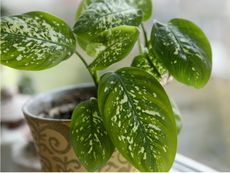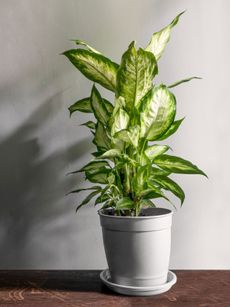Growing Dumbcane Dieffenbachia - How To Care For A Dieffenbachia Plant


Dieffenbachia is a beautiful specimen, highly adaptable and perfect as a living decoration for the home or office. Also known as dumb cane, the plant dieffenbachia is native to Central and South America and a relative of skunk cabbage. But unlike with its relatives, planting dumb cane will not result in a smelly household… just a long lasting plant with ease of care.
Quick Facts about Dieffenbachia
- Botanical name- Dieffenbachia
- Height - 12 inches - 6 feet
- Spread- similar to height
- Sun exposure-partial sun
- Soil requirements- loam to sand, well draining
- Hardiness zones- USDA 10-12
- When to plant- Spring
How to Care for a Dieffenbachia Plant
Dieffenbachia is called dumb cane because the plant contains raphides. These are defensive mechanisms in the plant that repel browsing animals. Ingestion of the leaves causes stinging and burning of the mouth for a couple of weeks. In humans, this reaction can hinder speech, hence the common name.
The plant is not recommended in households with pets or children. The plants may be as small as 12 inches (30 cm), but certain cultivars grow as large as 6 feet (2 m) in height, with a similar spread. Most Dieffenbachia are grown as houseplants, but they are hardy to United States Department of Agriculture zones 10-12.
Dieffenbachia Care Guidelines
Dumb cane is known as a low maintenance houseplant. The plant requires the proper lighting, temperatures, watering, and soil medium, just like any other plant. But once these needs are met, it has few disease or pest issues, especially when grown indoors. Mealybugs, mites, and aphids are common problems for outdoor plants. Root rot is the most common disease, caused by keeping the soil excessively moist. Providing the right amount of water is a main secret of dumb cane care.
Light Requirements
Dieffenbachia plants are understory specimens native to warm regions of the Americas. They prefer partial sun and their showy foliage can burn in full, southern exposures. These plants also perform well in full shade, but growth will remain slow.
Rotate your dieffenbachia houseplant regularly to provide adequate light to all sides and to prevent it from reaching toward the light on one side. When growing dumbcane dieffenbachia of various cultivars, check light requirements for the particular plant. Some dieffenbachia plants require low filtered light. Most cultivars do fine with a low light environment. The growth may slow or stop, but the plant will remain healthy and attractive.
Water
Dumb cane plant care requires consistently moist soil, but it should not be boggy. And any water remaining after irrigation in a dish should be emptied. Water the plant deeply but not again until a finger inserted to the second knuckle finds the soil dry. The plant likes high humidity, which can be provided in dry climates by placing the container on a saucer filled with pebbles and water. This will keep the roots from becoming soggy, but will evaporate and provide ambient moisture.
Gardening tips, videos, info and more delivered right to your inbox!
Sign up for the Gardening Know How newsletter today and receive a free download of our most popular eBook "How to Grow Delicious Tomatoes."
Planting & Repotting
This houseplant likes any type of potting soil, provided it drains well. A light to medium weight soil is preferred. If making your own soil, a combination of loam and peat will make a perfect medium. It can also grow in pure peat, but a 1:1 mix of soil and peat or peat and perlite is a nice option.
Dieffenbachia seguine should be re-potted regularly to refresh the soil and provide a larger container when necessary. Re-pot in early spring for best results. From March to September, feed with a water soluble fertilizer. A houseplant food high in nitrogen can be applied at half strength. Apply every 2 weeks and half strength. A time released food is also acceptable.
Propagating Dieffenbachia
Dieffenbachia propagation is simple. The plant may be reproduced from stem cuttings. Don protective gloves before taking a cutting, to avoid the sap. Cuttings should come from terminal ends or lateral buds. Remove 2 inches (5 cm) with a lateral bud attached. Allow the cutting to dry out for a day. Place the cut end into a moistened, soilless medium such as sand or perlite. Cuttings in Sphagnum moss establish more quickly than those in peat or sand.
Cuttings taken from the top of the plant will also root more quickly. Place the cut end in a glass of water in medium light. Change the water daily and pot it up when there is a thick complement of roots.
Dieffenbachia Problems, Pests & Diseases
As mentioned, overwatering can lead to the most common problem: root rot. Plants sitting in saucers filled with water often develop this issue. Other diseases are rare occurrences, but may include fungal leaf spot and blight. Avoid overhead watering and deliver the moisture directly to the roots.
As the plant ages, the lower leaves drop off, revealing the cane-like stem. This is natural and not a problem. Spider mites, scale, aphids, and mealybugs occur in plants placed outdoors for the growing season. Use a good horticultural soap or oil to combat these pests.
If other leaves appear bleached, with a webby substance on the underside, check and treat the plant for spider mites with insecticidal soap spray or neem oil. Don’t use chemicals for this issue, as it often makes the problem worse.
If you notice water droplets on the dumbcane plant, you may wonder, “Why does my dieffenbachia plant drip water?” This is the byproduct of the transpiration process, which is active in most plants. It's totally natural, and not a bad sign.
Is Dieffenbachia Poisonous?
While Dieffenbachia plant care is simple and straightforward, some words of caution. The plant’s sap can irritate the skin, so gloves and hand washing after handling the plant are necessary. When the sap gets into the mouth, it causes extreme burning in the soft tissue. Scar tissue can develop in the larynx which distorts sounds formed. The result is a “dumb” state from which recovery can take several weeks. Take care handling it, and keep it well away from children and pets.
Dieffenbachia Varieties
There are many cultivars of this popular houseplant. Most have been bred to focus on larger leaves, or variegated hues in the foliage. ‘Camille’ is probably the most commonly found cultivar. It is a bushy plant with creamy white markings on the leaves. ‘Exotica Alba’ has white centers on the leaves, while ‘ Hilo’ sports white veins. ‘Paradise’ has golden leaves covered in green speckles.
‘Snow Queen’ has lighter yellow leaves with green edges and white veins. ‘Rudolph Roehrs’ develops light yellow leaves, white spots, and green veins. One of the larger cultivars, ‘Tiki’, has silvery leaves with green and white blotches. A very tolerant low light specimen, Tropic Snow’, has dark green leaves with white along the veins.
Note: If chewed or eaten, dieffenbachia leaves can cause temporary swelling of the tongue and throat, leading to a temporary loss of speech (the source of the name dumbcane). While this is usually not serious, it can cause suffocation. Avoid placing the dumbcane plant where curious children or pets might be tempted to taste it.

Becca Badgett was a regular contributor to Gardening Know How for ten years. Co-author of the book How to Grow an EMERGENCY Garden, Becca specializes in succulent and cactus gardening.
- Bonnie L. GrantWriter
-
 Urban Composting Guide: How To Compost In The Middle Of The City
Urban Composting Guide: How To Compost In The Middle Of The CityUrban composting does not have to be daunting. You can compost in the city, and maybe even try some urban worm composting!
By Mary Ellen Ellis
-
 Shrub Diseases And Pests To Watch Out For
Shrub Diseases And Pests To Watch Out ForShrub diseases and pests can be challenging. Learn how to recognize and eradicate them before they can present a danger to your plants.
By Susan Albert
-
 Dieffenbachia Pruning Guide – Should You Cut Back Dieffenbachia Plants
Dieffenbachia Pruning Guide – Should You Cut Back Dieffenbachia PlantsDieffenbachia can tend to get leggy and grow unwieldy top growth in some situations. That’s when you know it is time to cut it back.
By Bonnie L. Grant
-
 Dieffenbachia Troubleshooting – Learn About Dieffenbachia Diseases
Dieffenbachia Troubleshooting – Learn About Dieffenbachia DiseasesDon’t be surprised if you have problems with dieffenbachia, as it is no different from other plants when it comes to this. Read on for tips.
By Becca Badgett
-
 Dieffenbachia Care In Winter: How To Winterize Dieffenbachia Plants
Dieffenbachia Care In Winter: How To Winterize Dieffenbachia PlantsOverwintering houseplants is important, and dieffenbachia needs specific conditions in the winter. Click this article for more information.
By Mary Ellen Ellis
-
 Propagating A Dieffenbachia: How To Propagate Dieffenbachia Plants
Propagating A Dieffenbachia: How To Propagate Dieffenbachia PlantsDieffenbachia is an attractive houseplant that adds a tropical statement to almost any room. You have the potential for an endless supply of new plants by propagating cuttings, and this article will help.
By Anne Baley